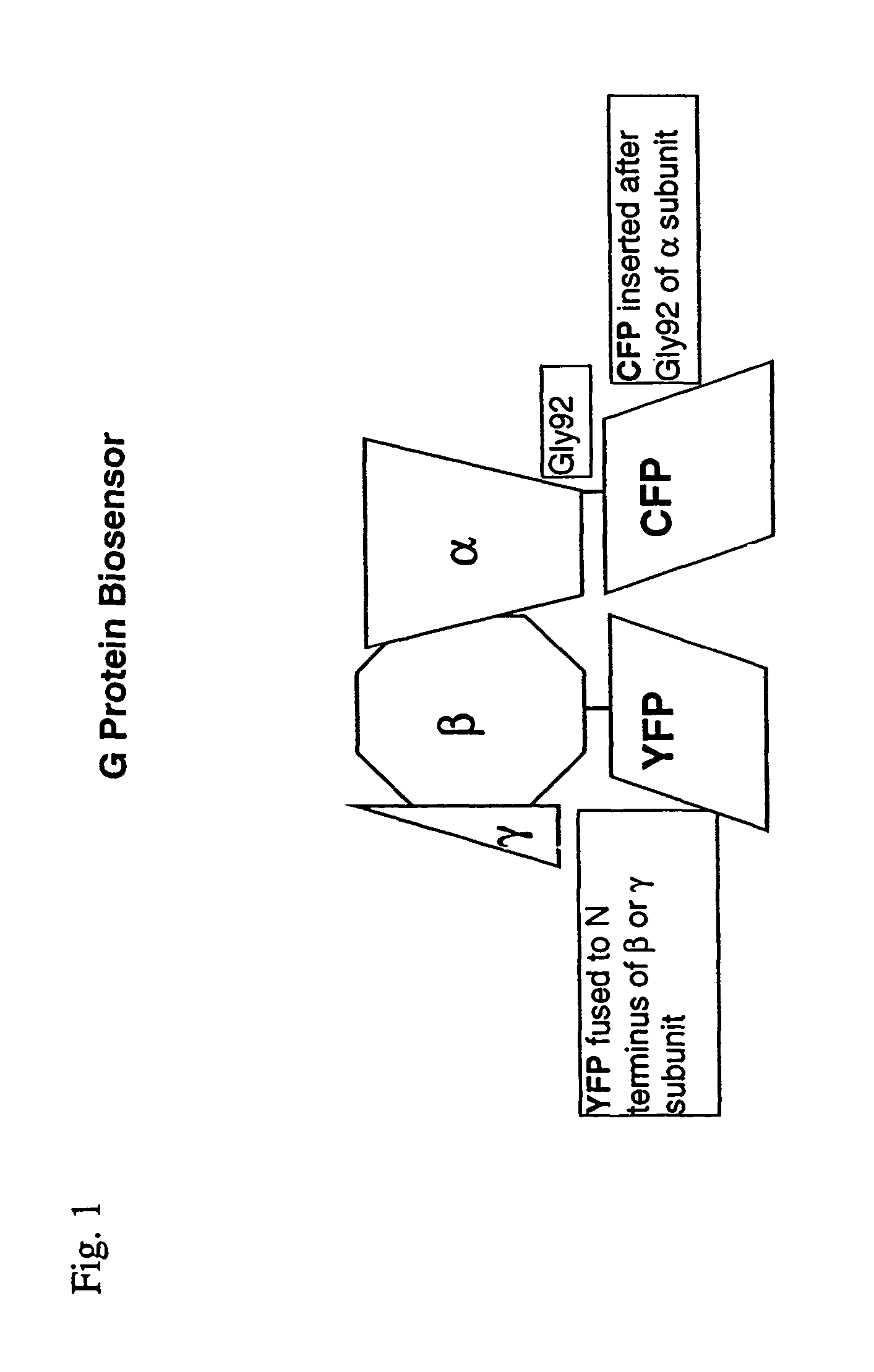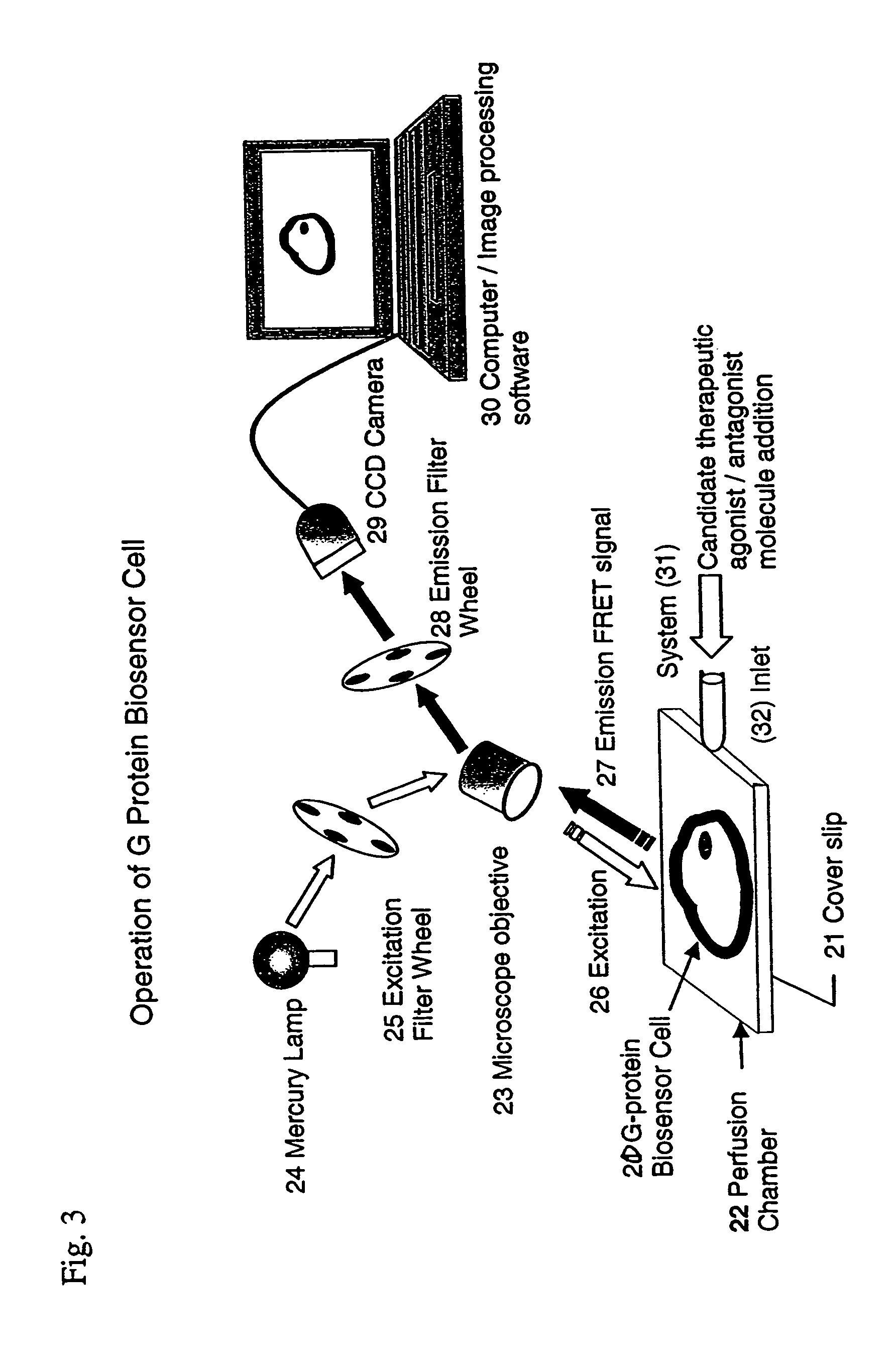Biosensor and use thereof to identify therapeutic drug molecules and molecules binding orphan receptors
a biosensor and drug candidate technology, applied in the field of recombinant dna technology, can solve the problems of insufficient information about the behavior of these signaling pathways, undesired serious limitation in the methods available to screen drug candidates non-invasively using mammalian g protein coupled receptors and g proteins, lack of information about temporal changes and spatial localization, etc., to achieve the effect of increasing the range and depth of candidate molecules
- Summary
- Abstract
- Description
- Claims
- Application Information
AI Technical Summary
Benefits of technology
Problems solved by technology
Method used
Image
Examples
example 1
[0159]A mammalian G protein biosensor was prepared following the aforedescribed procedure herein functional and produced a FRET signal to test whether FRET occurred from α-CFP to β-YFP. YFP was bleached by illuminating for 4 min using the D500 / 20× excitation filter (YY set). The intensity of fluorescence emission from CFP was examined before and after bleaching. The CC signal increased about 3 to about 7% after YFP was bleached indicating that the biosensor cell was function and that FRET did occur from CFP to YFP in these fusion proteins This result also showed that the subunit fusions do form a heterotrimer.
[0160]The biosensor cell of this biological system is living because it has been cultured on the cover glass to which they are attached during operation and they have multiplied there and also respond to an extracellular signals with expected physiological response. The ability to reproduce and response to the environment characterizes them as living.
[0161]The biosensor cell is...
example 2
[0165]The functional G protein biosensor cell responded to an agonist molecule. Images of biosensor cells were acquired (captured) at regular time intervals of 15 sec before and after the addition of a muscarinic acetylcholine receptor agonist drug, carbachol. The FRET profile of the CY / CC ratio was plotted over time and is shown in FIG. 5. The FRET signal intensity decreases in the presence of the agonist drug. FRET images of biosensor cells were acquired and analyzed before and after exposure to carbachol as described in the Procedures for Design and Operation following. Timing of various agonist additions to the biosensor cell are indicated with arrows on FIG. 5. Plots show a downward trend because of partial bleaching over the period of the test. The graph is representative of data from ten tests. The results show that the ratio decreases strikingly when the muscarinic receptor agonist drug, carbachol is introduced into the perfusion chamber containing the cells.
example 3
[0166]The functioning G protein biosensor cell responded quantitatively and reproducibly to an agonist drug. The response of biosensor cells to the addition of varying concentrations of carbachol were measured as described earlier. The FRET signal intensity changes is directly and positively correlated with increases in agonist drug concentration (FIG. 6). Details are provided in Procedures for Design and Operation. Points are means±SEM of three tests. The data curve was fitted using GraphPad (Prizm). FRET signal intensity is decreased by agonist drug addition. Tests were performed as described hereinafter in Detailed Description of the Invention.
[0167]The EC50 for carbachol activation of the G protein is about 600 nM which is consistent with the EC50 for carbachol mediated M2 activation of a G protein measured in a reconstituted system (15).
PUM
 Login to View More
Login to View More Abstract
Description
Claims
Application Information
 Login to View More
Login to View More - R&D
- Intellectual Property
- Life Sciences
- Materials
- Tech Scout
- Unparalleled Data Quality
- Higher Quality Content
- 60% Fewer Hallucinations
Browse by: Latest US Patents, China's latest patents, Technical Efficacy Thesaurus, Application Domain, Technology Topic, Popular Technical Reports.
© 2025 PatSnap. All rights reserved.Legal|Privacy policy|Modern Slavery Act Transparency Statement|Sitemap|About US| Contact US: help@patsnap.com



